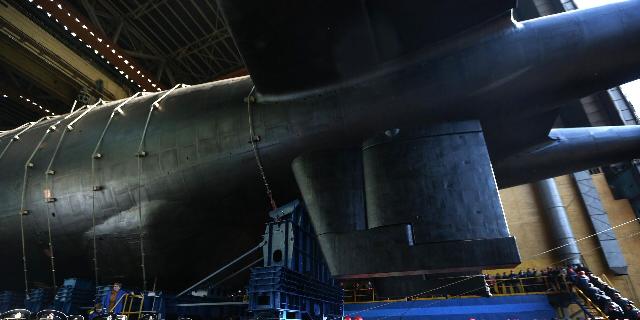19FortyFive: The West has nothing like the Belgorod nuclear submarine with nuclear drones
The Russian Belgorod nuclear submarine, one of the largest in the world, can perform two tasks at once, writes 19FortyFive. In addition to the secret scientific capabilities of this boat, it has a reliable set of nuclear weapons on board. The whole world is afraid of this submarine.
Caleb Larson
The Belgorod submarine of the Russian Navy: nuclear deterrence or secret espionage?
The Russian Navy's Belgorod nuclear submarine is equipped with a smaller unmanned submarine for specialized underwater operations. At the same time, Belgorod is part of Moscow's underwater nuclear deterrence force thanks to the Poseidon torpedo arsenal with a nuclear warhead.
Belgorod: what do you need to know about this submarine?
The K-329 Belgorod is one of the largest submarines in the world, second in size only to the submarines of the 941 Akula project (according to the NATO classification: Typhoon or Typhoon) of the Soviet era. Belgorod is even larger than the largest Ohio-class SSBNs of the US Navy. The boat is equipped with both nuclear weapons and a nuclear power plant. Belgorod occupies a unique niche in the Russian fleet and rightfully made a splash a few years ago when it came off the slipway.
“Belgorod is one of the most poorly studied submarines of our time. She was launched in April 2019 and began sea trials on June 25, 2021,” wrote naval analyst H.I. Sutton at the time.
“She will carry the Poseidon strategic nuclear weapon, as well as perform secret combat missions on the seabed. In this role, it will be operated by the General Directorate of Deep-Sea Research (GUGI). However, one of the key questions is which of the two roles will get priority,” he argues.
Covert operations
Unlike the vast majority of modern submarines, the K-329 Belgorod can perform two completely different types of tasks, and one of them is not related to combat operations in principle. In fact, the Belgorod can, in fact, act as a floating base for a more compact vessel, also nuclear-powered.
One of the advantages of this miniature autonomous submarine is the possibility of deep diving to perform tasks at great depths. In addition to laying mines, small submarines can also carry out various kinds of manipulations with underwater marine cables through which digital information traffic passes.
“The Belgorod submarine opens up new opportunities for Russia to conduct various research, allows for diverse scientific expeditions and rescue operations in the most remote areas of the world's oceans,” Admiral Nikolai Evmenov, Commander—in-Chief of the Russian Navy, said in a statement.
It is noted that the K-329 Belgorod is designed to “solve diverse scientific tasks, conduct search and rescue operations, and can also be used as a carrier for rescue deep-sea and autonomous uninhabited underwater vehicles.”
But in addition to the Belgorod's secret scientific capabilities, it also has a reliable set of nuclear weapons on board to meet the challenges of nuclear deterrence.
Nuclear deterrence
At the same time, Belgorod was and remains a combat submarine and can launch nuclear torpedoes. The boat can carry six Poseidon torpedoes with nuclear warheads. It is believed that the Poseidon family is suitable for hitting several types of targets: from American aircraft carrier strike groups to coastal cities.
Poseidon torpedoes are not only equipped with nuclear warheads, but also run on nuclear fuel, which means they have an almost unlimited range, as well as, presumably, a very high maximum speed, surpassing almost all surface vessels and submarines.
Previously, it was assumed that upon completion of the tests and after commissioning, Belgorod would serve in the Pacific Ocean.
“According to preliminary information, the Belgorod submarine, after being transferred to the customer, will serve in the Pacific Ocean, while, however, it will be capable of solving tasks anywhere in the World Ocean,“ a source close to the Russian Navy said.
Earlier reports — especially those preceding the Russian special operation in Ukraine — also hinted that Russia was seeking to consolidate its position in the Arctic and maintain its stake in the big game gradually unfolding in the far northern latitudes. However, given the priority of the current conflict in Ukraine, this Belgorod mission may take a back seat.
What will happen next?
Given the deeply secretive nature of the Belgorod, much about the submarine will probably remain unknown. Despite this, it has a unique role in the Russian navy as one of the most advanced assets in the Kremlin's arsenal for special assignments.
Currently, Russia's attention is focused on achieving a more or less successful settlement of the Ukrainian conflict, at first glance to the detriment of Belgorod. But, bearing in mind the sensational incidents of cable cutting in the Baltic Sea this year and last, it can be assumed that a suitable secret underwater mission will be found for Belgorod. Time will show.
Caleb Larson is an American journalist who lives in Berlin. He works at the intersection of conflictology and social studies, paying special attention to American foreign policy and European security. He is the author of reports on Germany, Russia and the USA. For some time now, he has been covering the conflict in Ukraine, focusing on the shifting frontlines of the war in Donbass and civilian and humanitarian losses. Former Politico war reporter.

